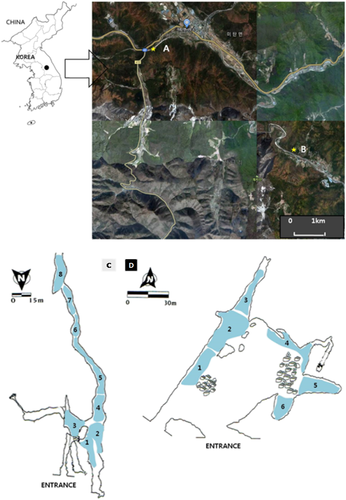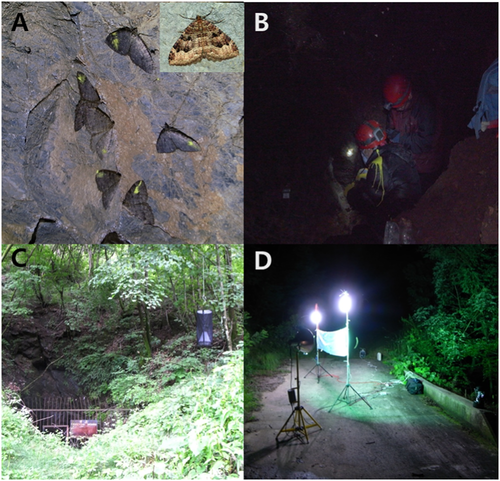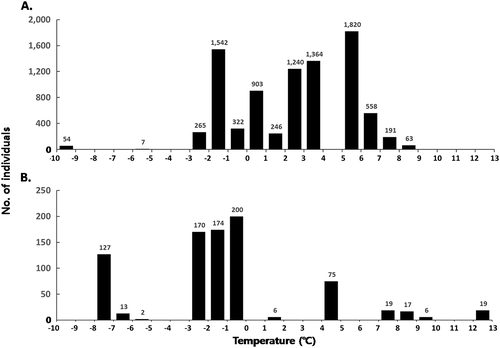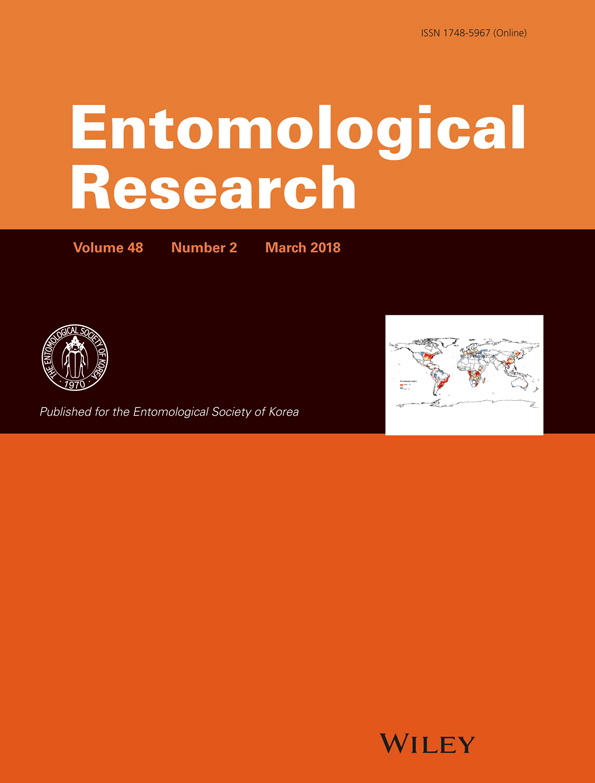Ecological characteristics of a cave-dwelling moth species, Triphosa dubitata (Lepidoptera: Geometridae), in Baram and Ssang caves in Gangwon Province, Korea
Abstract
This study was performed to clarify the ecological characteristics of a cave-dwelling moth species, Triphosa dubitata Linnaeus (Lepidoptera: Geometridae), at Baram cave and at Ssang cave within Pyeongchang-gun of Gangwon province in south Korea. We investigated T. dubitata population for 3 days from March 2013 to October 2013 (except September) and in January 2014. We used a section investigation method in the caves every month to determine their ecological characteristic. A nocturnal investigation using a high intensity discharge lamp adjacent to the entrance of the cave was conducted in parallel with a diurnal investigation using butterfly traps to investigate the movement of T. dubitata. In order to investigate the range of habitat temperature of moths, we used a dual laser targeting infrared thermometer to measure the cave temperatures. We caught individuals of T. dubitata L.: 8,574 individuals in Baram cave and 828 individuals in Ssang cave. As 9,095 individuals (97 %) appeared at a temperature of −3°C ~ 8°C, it was verified that the adults were living at specific temperatures. In addition, T. dubitata adults were not active outside the caves; they entered the cave as soon as they developed from pupa into adults. These results showed that T. dubitata depended on food plants outside of the cave during the egg–larva–pupa stages, and they used the cave as a habitat for long-term survival when they develop into adults.
Introduction
Moth species have various life cycles including dormancy as an adult via the egg, larval, and pupal stages (Shin 2001). Dormancy is a physiological response to delay or stop growth to cope with an extreme environment such as a hot summer and cold winter, and the choice of dormant habitat has an important impact on survival of the population (Mansingh 1971). Various locations are used for dormancy and are determined by the local effects of an area such as gradient, slope direction and vegetation, the state of the ground surface, and the amount of snowfall (Flohn 1969).
Dormant habitats for moth adults are rock cracks, old house walls, wood piles, and caves (Dvorak et al. 2009). Among them, because caves have less change in year-round temperature, they are suitable dormant habitats for species sensitive to temperature (Tercafs 2000). Thus, a cave not only plays a role as a habitat for organisms but also it allows for the evolution of body structure so that it is adapted to the cave environment (Culver et al. 1995).
Studies on organisms that live in caves have mainly investigated organism diversity rather than a specific group (Peck 1988; Kjaerandsen 1993; Cokendolpher & Polyak 1996; Wynne & Pleytez 2005; Son & Kim 2008). Ecological research on moths in caves has not actively progressed, because information about caves, such as the position and scale of the cave is lacking, they are often difficult to access, and it is difficult to prepare caving equipment (Skalski 1972). For these reasons, taxonomic research on unrecorded species observed in caves is more frequent rather than ecological research (Weinstein & Edwards 1994; Medeiros et al. 2009).
17 moth species in Korea species of moths such as Triphosa dubitata, Triphosa sericata, Apamea sodalis, Apopestes koreana, Scoliopteryx libatrix, Dicranura ulmi tsvetaevi, and Idiotephria amelia have been found in caves (Kim & Choi 2000, 2001).
Especially, Triphosa dubitata have been frequently observed by cavers in many caves in Korea, except from April to early June (Choi et al. 2005, 2011). A cave search report found that T. dubitata is distributed throughout Korea, and that the adults lived during the summer in caves, and they oviposited during the spring of the following year (Shin 2001). Rhamnus davurica and Crataegus pinnatifida (Park et al. 2012).
This study was performed to clarify the ecological characteristics of a cave-dwelling moth species, T. dubitata.
Materials and Methods
Study site
There are about 130 natural caves within Pyeongchang-gun, Gangwon province in south Korea (Pyeongchang-gun 2005). For this study, we selected two caves, Baram cave and Ssang cave, because we found that T. dubitata moths dwell in the two caves. The first Baram cave is located at Chang-ri, Mitan-myeon, Pyeongchang-gun (37°20′07.6″N, 128°29′13.5″E), and its altitude is 463 m. Its entrance is oval shaped (5 m width × 7 m height) and the total length of the cave is about 340 m (Fig. 1). Ssang cave is located at Gihwa-ri, Mitan-myeon, Pyeongchang-gun (37°18′36.9″N, 128°31′51.5″E), and its altitude is 276 m. The name of Ssang means twin in Korean and the Ssang cave is so called because there are two cave entrances. Both entrances of the Ssang cave are also oval shaped with different height (5 m width × 7 m height and 5 m width × 3 m height) and the total length of the cave is 150 m (Fig. 1). Practically, except for the entrance to the cave, it was difficult to measure the height of the inner side of the cave. Most of the cave interior was very irregular and had many sharp rock formations, except for the street, and it was difficult to access the inside of the cave. In fact, the height of the cave was a big difference from 1 to 12 m in the same section. Most of the existing cave drawings show characters using only the length accumulated. The map of the cave is also the form used in this study.

Moth collecting method and data analysis
We investigated T. dubitata population for 3 days every month from March 2013 to October 2013 (except September) and in January 2014. To measure the moth population, we used the section investigation method. After dividing the cave into several sections according to the consistent terrain shapes, we recorded the individual number of moths at the different sections in the cave (Fig. 1). Moths were gathered in a high intensity discharge lamp (200 W) and butterfly traps were set up at the cave. The nocturnal light was used in parallel with a method that attracted adults into a butterfly trap (40 cm diameter × 100 cm height) by placing some fruits and beverages at the entrance to the cave. The individual number of moths observed in the cave was compared among each section, and the number of dead individuals during the investigation period was counted as well. Because the dead individuals were eaten by predators and only their wings remained, the wings were counted and divided by four (number of wings on a moth). In order to investigate the range of habitat temperature of moths, we used a dual laser targeting infrared thermometer to measure the cave temperatures (Ruby Electronics, DT8865; −50°C ~ 1000°C, ± 0.1 %). The adults were caught in the cave by using a sweeping net. They were marked with a paint brush on their wings to understand the behavioral habits of T. dubitata. The temperature in every section was recorded (Fig. 2). The different species of moths and bats observed during the course of the investigation were classified and identified. The hypothesis test was conducted using the statistical program R (Ross Ihaka and Robert Gentleman) ver. 3.0.3 after arranging the number of individuals observed in each 1°C section.

Results
Number of the moth individuals by sections and temperatures
A total of 8,574 individual T. dubitata were collected in the Baram cave in 2013–2014. There were 6,772 individuals in 2013 and 1,802 individuals in 2014 (Table 1). The 828 individuals found in Ssang cave: 798 individuals were found in 2013 and 30 individuals in 2014 (Table 2). More individuals were observed at the entrance of Baram cave than those in Ssang cave. The number of individuals observed in each section was larger in the Ssang cave than that in Baram cave. The temperature of the section where the greatest number of T. dubitata individuals was observed was −3°C ~ 8°C, and 9,095 (96.7 %) individuals were observed at the temperature range (Fig. 3). As a result of the statistical analysis, the probability that T. dubitata was distributed at −3 – 8°C was >96 % (X2 = 12.64, df = 1, P = 0.00037). A total of 1,505 individuals were observed in March 2013 in Baram cave and 1,802 were observed in January 2014, but only 398 and 30 individuals were observed in Ssang cave during these two times. This result probably occurred due to the little change in temperature in Baram cave, whereas Ssang cave is influenced by changes in external temperature from the two large entrances, and the monthly temperature in the cave changed significantly. The more moths were observed in Baram cave because the temperature range that moths prefer to move was in the section adjacent to the cave entrance. However, moths in Ssang cave moved along their preferred temperature but were no longer observed in sections with temperature > 8°C.
| Month | Moth status | Section number | Total number of months | |||||||||||||||
|---|---|---|---|---|---|---|---|---|---|---|---|---|---|---|---|---|---|---|
| 1 | 2 | 3 | 4 | 5 | 6 | 7 | 8 | |||||||||||
| NO | TM(°C) | NO | TM(°C) | NO | TM(°C) | NO | TM(°C) | NO | TM(°C) | NO | TM(°C) | NO | TM(°C) | NO | TM(°C) | |||
| ’13 March | Live | 263 | −2.5 | 125 | −1.2 | 322 | −0.8 | 308 | 0.8 | 202 | 0.6 | 118 | 0.9 | 100 | 1.3 | 67 | 1.3 | 1,505 |
| Death | - | - | - | - | - | - | - | - | - | |||||||||
| April | Live | 2 | −2.8 | - | −1.0 | 13 | 1.3 | 1 | −2.0 | 1 | 0.9 | 1 | 1.3 | - | 1.2 | - | 2.3 | 18 |
| Death | 228 | 5 | 4 | 93 | - | 2 | - | - | 332 | |||||||||
| May | Live | - | −3.1 | - | −1.0 | - | 4.4 | - | −2.2 | - | −0.5 | - | −1.3 | - | 1.0 | - | 2.6 | - |
| Death | - | - | - | - | - | - | - | - | - | |||||||||
| June | Live | 7 | −5.2 | 37 | −1.4 | 5 | 8.6 | 4 | 2.4 | 4 | 2.8 | 1 | 3.2 | - | 4.6 | - | 4.8 | 58 |
| Death | - | - | - | - | - | - | - | - | - | |||||||||
| July | Live | 274 | 0.3 | 755 | −1.4 | 235 | 5.1 | 770 | 3.5 | 62 | 5.6 | - | 7.0 | - | 7.4 | - | 7.1 | 2,096 |
| Death | 114 | - | - | 49 | - | - | - | - | 163 | |||||||||
| August | Live | 54 | −10.0 | 624 | −2.0 | 32 | 2.4 | 346 | 5.8 | 84 | 7.2 | 18 | 7.4 | - | 7.2 | - | 3.6 | 1,158 |
| Death | - | - | - | - | - | - | - | - | - | |||||||||
| October | Live | 65 | 1.9 | 1,200 | 2.3 | 19 | 5.3 | 319 | 6.5 | 329 | 5.8 | 3 | 7.1 | 2 | 7.1 | - | 6.9 | 1,937 |
| Death | - | - | - | - | - | - | - | - | - | |||||||||
| ’14 January | Live | - | −1.4 | 592 | 3.5 | 69 | 7.7 | 282 | 5.5 | 547 | 5.7 | 239 | 6.3 | 15 | 7.3 | 58 | 8.0 | 1,802 |
| Death | - | - | - | - | - | - | - | - | ||||||||||
| Total | Live | 665 | 3,333 | 695 | 2,030 | 1,229 | 380 | 117 | 125 | 8,574 | ||||||||
| Death | 342 | 5 | 4 | 142 | - | 2 | - | - | 495 | |||||||||
| Month | Moth status | Section number | Total number of months | |||||||||||
|---|---|---|---|---|---|---|---|---|---|---|---|---|---|---|
| 1 | 2 | 3 | 4 | 5 | 6 | |||||||||
| NO | TM(°C) | NO | TM(°C) | NO | TM(°C) | NO | TM(°C) | NO | TM(°C) | NO | TM(°C) | |||
| ’13 March | Live | 45 | 4.3 | 17 | 7.9 | 6 | 9.1 | 158 | −2.9 | 59 | −1.6 | 113 | −0.6 | 398 |
| Death | - | - | - | - | - | - | - | |||||||
| April | Live | 2 | 7.2 | 1 | 8.0 | - | 8.3 | 2 | −5.2 | - | −3.9 | 1 | −7.3 | 6 |
| Death | - | - | - | - | - | - | - | |||||||
| May | Live | - | 9.6 | - | 8.0 | - | 6.8 | - | −7.1 | - | −9.5 | - | −10.0 | - |
| Death | - | - | - | - | - | - | - | |||||||
| June | Live | - | 15.0 | - | 12.4 | - | 10.4 | 37 | −1.2 | 72 | −7.9 | 54 | −7.4 | 163 |
| Death | - | - | - | - | - | - | - | |||||||
| July | Live | - | 20.1 | - | 18.0 | - | 16.6 | 6 | 1.8 | 87 | −0.4 | 62 | −1.6 | 155 |
| Death | - | - | - | 6 | 5 | 2 | 13 | |||||||
| August | Live | - | 18.5 | - | 16.7 | - | 14.6 | 12 | −2.5 | 13 | −6.4 | 16 | −1.6 | 41 |
| Death | - | - | ||||||||||||
| October | Live | - | 23.6 | - | 23.6 | - | 22.6 | 19 | 12.3 | 16 | 8.3 | - | 7.8 | 35 |
| Death | - | - | - | - | - | - | - | |||||||
| ’14 January | Live | - | 9.3 | - | 14.7 | - | 16.4 | 9 | 4.4 | 17 | 4.1 | 4 | 4.0 | 30 |
| Death | - | - | - | - | - | - | - | |||||||
| Total | Live | 47 | 18 | 6 | 243 | 264 | 250 | 828 | ||||||
| Death | - | - | - | 6 | 5 | 2 | 13 | |||||||

Seasonal migration characteristics of the moth population
The T. dubitata population laid eggs on food plants in April, they became new adults, and the new adult moths began to return with old adults to the cave from June. It was confirmed that most individuals returned to the cave in July (Table 1). When moths were on migration in April and in July, they were intensively preyed upon by bats (Table 1).
Other cave-dwelling moth species and two bat species
Other moth species observed in Baram and Ssang caves were Apopestes indica, Idiotephria amelia, Erebomorpha fulguraria, Ebecliptopera decurrens, and Axylia putris. Apopestes indica moth species, which passes the winter as an adult stage, were observed irregularly in summer. Two bat species were Myotis pentax and Rhinolophus ferrumequinum and they were irregularly observed as moths' predators.
Discussion
In this investigation, the surface temperature of rocks was measured by considering that the moths spend most of their time attached on the surface of a rock. The atmosphere temperature in the cave depends on the surface temperature of the rocks and the atmospheric temperature flowing from the outside of the cave (Perry 2013). T. dubitata was not observed in the night light or the butterfly trap that was placed outside the cave during this investigation. In addition, T. dubitata has not been observed in night lights placed at other locations. This phenomenon occurs because T. dubitata living in a cave fly toward dark locations due to a negative phototactic response to light, and this behavior disappears after winter (Tercafs & Thines 1973; Leather et al. 1993).
Our results show that insect life histories vary in caves. Moths are classified into species in which larva prefer to live in a cave, species that use caves for wintering, species that spend the summer in a cave, species observed regardless of season, species randomly observed, and species observed by accident (Kjaerandsen 1993). T. dubitata has a life cycle that includes food activity and mating in a cave and traveling outside the cave to find food in April. T. dubitata live on plants until June when the larvae incubate from eggs become pupae (Park et al. 2012). Then, the moth becomes an adult, which travels back into the cave. The cave plays a role as a habitat for the adult stage T. dubitata beyond simple dormancy or passing the winter. This differs from living the entire life cycle in a cave such as Pyralis manihotalis, which depends on bat excretion for food and Schrankia howarthi,which eats plant roots inside caves (Weinstein & Edwards 1994; Medeiros et al. 2009).
Because 97 % of T. dubitata were observed at −3°C ~ 8°C, this is the temperature range at which adults can live for the long term during summer and winter. These results are similar to the results for the noctuid moth adult (Scoliopteryx libatrix), which lives up to 14 months at 5°C (cave temperature) (Mckillop 1993).
It is seen that the T. dubitata are intensively predated at the time of going out of the cave to lay eggs and coming into the cave after having turned into an adult. It was verified that the Baram cave is intensively predated in two areas within the cave, in which the Myotis pentax of 20 individuals and the Rhinolophus ferrumequinum of two individuals inhabit. The M. pentax, which forms a population of more than 50 individuals in the Ssanng cave, suffers predation by bats in the entire cave. Bats prey intensively upon >90 % of noctuid Goniocraspidum preyeri diapausing in the cave in March and are used as a main energy source for overwintering bats (Sano 2006).
Unlike lepidopteran insects that spend their whole life cycle within a cave, T. dubitata depend on the food plants Rhamnus davurica and the Crataegus pinnatifida, outside of the cave during the egg–larva–pupa stages, but they live in the cave for long-term survival once they develop into adults. The correlation between body temperature of a bat and cave temperature is analyzed by measuring the surface temperature of the rock during their hibernacula (Kim et al. 2013).
Acknowledgments
This work was supported by the NIE (National Institute of Ecology) and Seoul Women's University research funds.




